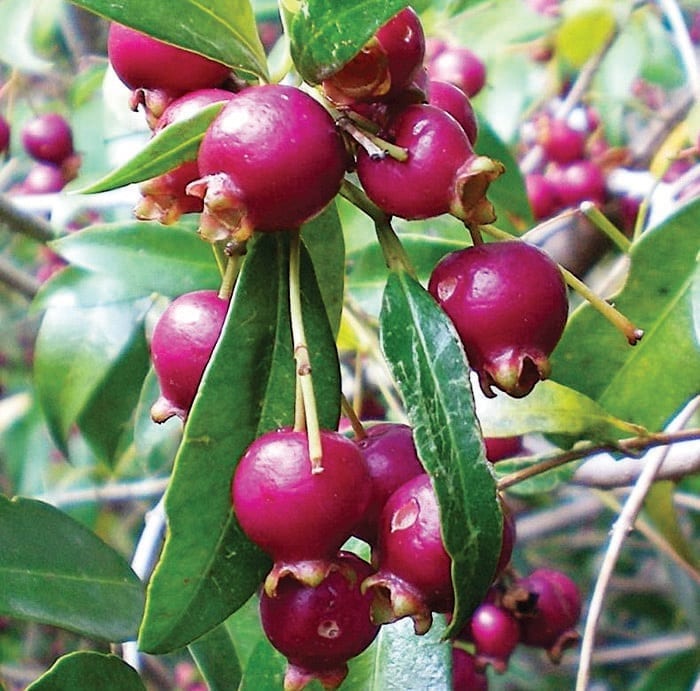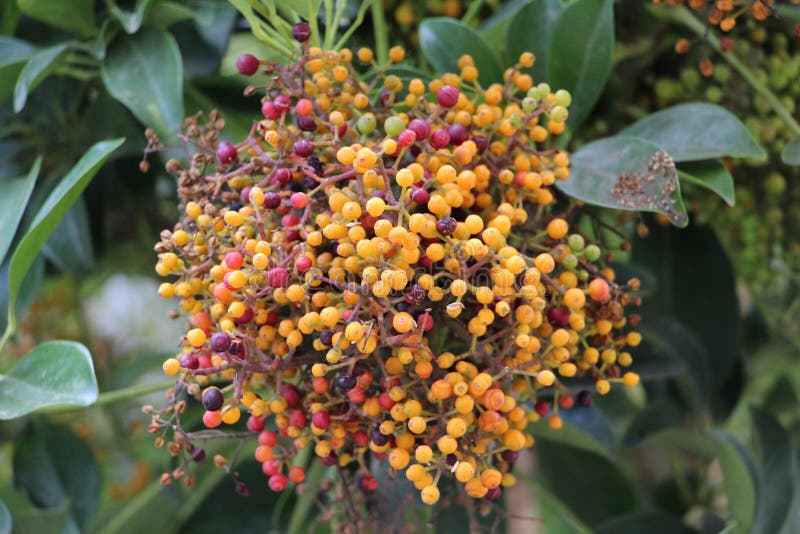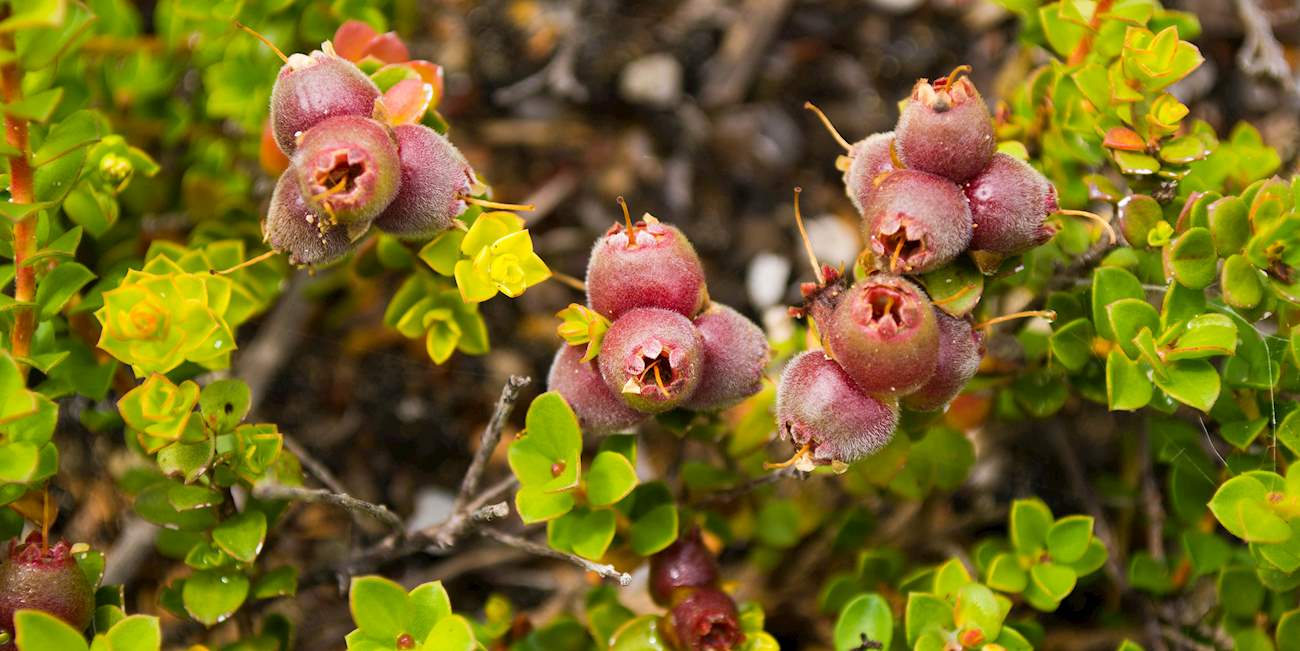Fruit & Vegetables Aussie Bush Tucker An Introduction to Common Native Foods of Australia
Syzygium Australe Lilly Pilly Lilly pillies are popular Australian natives that grow in a variety of conditions and soil types. They're commonly grown as hedges and make perfect screening plants. There are around 60 different Lilly Pilly varieties that are native to Australia and Southeast Asia.

Blue berries of Australian native ginger, Alpinia caerulea growing in the understorey of sub
And for fabulous low-maintenance tub plants, dwarf acacias like 'Limelight' and 'Green Mist' are winners.". There are many stunning Australian native plants to choose from, here is a top 30 list of some of the most popular. 1. Australian daisy (Brachyscome) 2. Banksia (Banksias)

Wombat berry is an evergreen vine native to Malanesia, the Pacific Islands and Nothern Australia
Bush tucker, or bush food, is any food native to Australia. The Australian Aboriginals used the environment around them for generations, living off a diet high in protein, fibre, and micronutrients, and low in sugars. Much of the bush tucker eaten then is still available and eaten today. We guide you through it here. Food from Animals
Top 10 Australian native foods you need in your kitchen Features ABC Environment (Australian
Tucker Bush Cherry. A variant of the popular Lilly Pilly, the Tucker Bush Cherry is an Australian native that produces red berries. These edible berries can be added to jams, cakes, wines, or eaten fresh. The Tucker Bush Cherry can grow up to 4 metres high and has delicate white flowers that appear during the warmer months of the year.

Australian Native Lilly Pilly Berries
Native edible plants include berries, grass seeds, plant roots, seeds, leaves and flowers. When eating bush foods, care must be taken to identify the plant correctly to ensure the plant is edible and to factor

Edible Australian Native Ginger berries Alpinia caeruleaa a photo on Flickriver
Wombat berry (Eustrephus latifolius) is an evergreen climbing or scrambling native Australian plant that can reach up to six metres into the tree canopy in ideal conditions. The tubers were eaten by various Indigenous people of Australia and have a mildly sweet, earthy taste.

Purple AppleBerry / Billardiera longiflora Australian native plants, Australian plants
Introducing the Apple Berry Plant. The Apple Berry is native to Australia and is a great looking and incredibly versatile plant. It's a climbing plant that can be used as a screen or groundcover, but also a shrub in a pot. Billardiera scandens is incredibly tough and adapts well to any conditions. It doesn't need much maintenance either.

blue berry ginger, found in coastal rainforests in eastern Australia. Weird Fruit, Australian
1. Native Rivermint Long used in Aboriginal culture as a flavoursome bushfood, insect repellant and medicinal herb, native rivermint can be used dried or fresh anywhere. 2. Midyim berries

A Guide To Bush Tucker Australia's Native Foods
From the iconic Quandong to the vibrant lemon myrtle, our website offers an extensive range of Australian native seeds for you to grow and enjoy in your own backyard. Embrace the rich cultural heritage of Aboriginal communities by exploring the unique tastes and nutritional benefits of these indigenous plants.

Australian native Snowberries grow in the chilly wet forests and subalpine regions of Tasmania
Native berries to plant in your patch | Organic Gardener Magazine Australia Native berries to plant in your patch Photo: Karen Sutherland Midyim berry, Austromyrtus dulcis, is a tasty and rewarding native fruiting plant that is also super easy for the home gardener to tackle.

EDIBLE NATIVE PLANT LIST SUNSHINE COAST REGION Part 1 The Bribie Islander
Riberry is a pear-shaped fruit that bare a bright cherry red colour that eventually fades to pink when cooked. It is native to the sub-tropical areas in Queensland and New South Wales. For thousands of years, the Aboriginals on The East Coast relied on the riberry as a core food source. This tiny bright-pink berry is sweet and sour, spicy and.

Native Australian Berries stock photo. Image of palm 56087320
Originating in northern Queensland, this 6m tree with small, grey-green leaves imparts an uplifting citrus flavour with rosemary overtones. It can be used in sweet and savoury dishes and herbal teas, or mixed with mountain pepper for a lemon-pepper sprinkle. The quality of its oil also makes it an ideal candidate for aromatherapy and perfumery.

Midyim (Austromyrtus dulcis) This is a delicate sweet berry. Excellent fresh. Keep an eye on my
The native finger lime is a small, thorny evergreen shrub, but its petite, oval (finger-shaped) fruit is tasty and rewarding to grow. Inside the skin are small, tangy beads of citrus pulp. This tree can be pruned and shaped. There are many named varieties with fruit with green, pink, red, yellow or orange tinged colours. Height: 2-7m; width: 2-5m.

Australian Native Plant Profile Wombat Berry (Eustrephus latifolius) Dengarden
Known as emu apples or native cranberries Muntries are a low growing shrub found on the south coast of Australia. When ripe the berries are green with a red tinge and have the flavour of spicy apples. Muntries are a berry that grow on the plant Kunzea pomifera that is indigenous to the southern coast of Australia.

Midyim Berries Permablitz Melbourne
A guide to edible native Australian plants. by Meg Thompson June 3, 2019. In Australia, we have more than 5000 species of edible native plants. However, if you asked the average Australian to name some, they may struggle to get past macadamia and lemon myrtle. In researching this article I have had the loveliest time learning the stories of.

3 Most Popular Australian Berries TasteAtlas
Pepper berry action is attributed largely to polygodial, a sesquiterpene dialdehyde which is present in other Australian native berries including Dorrigo pepper (Beattie, 2002). Polygodial is known to inhibit attachment of blue mussel larvae which leads to marine fouling (Ban, Singh, & Etoh, 2000).